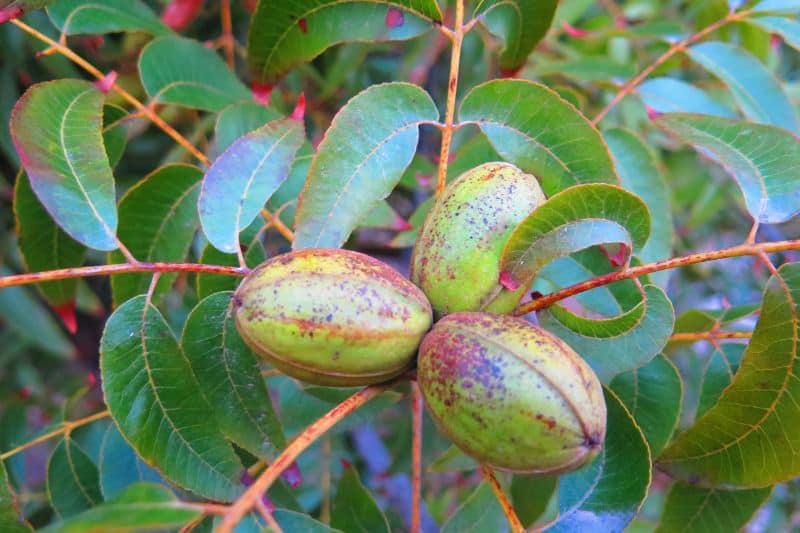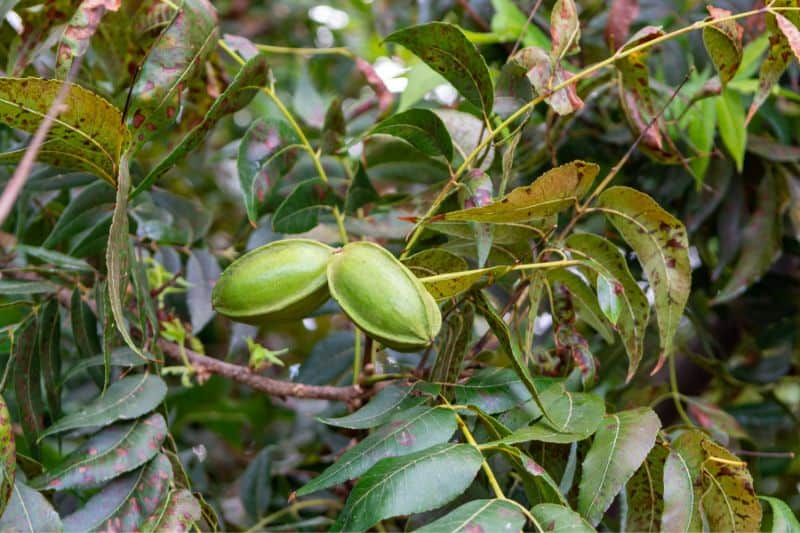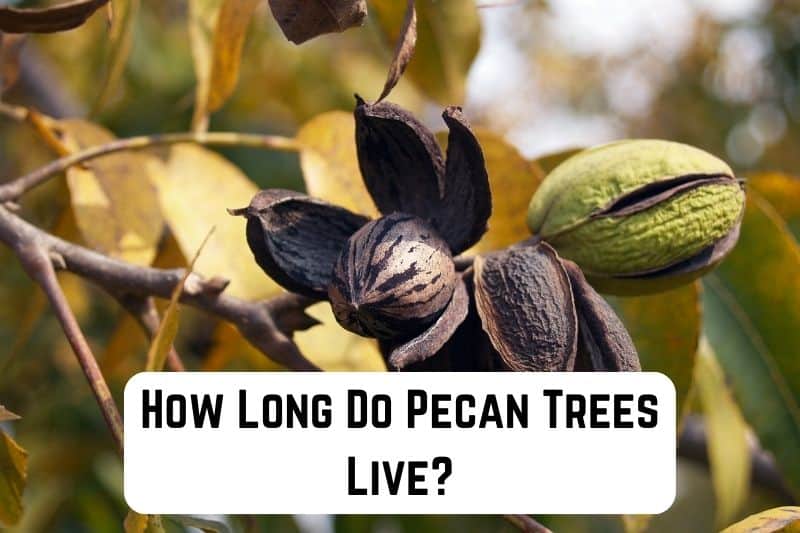If you love pecan nuts, you should consider growing your own pecan tree so you can harvest these tasty foods in your backyard. Pecan trees require lots of space to grow, but they provide beautiful landscaping and shade in the garden.
These trees are identified by their long, grayish-brown bark that becomes puckered as the tree ages. They can grow to a height of up to 100 feet (30.48m) with a spread of approximately 40 feet (12m). But, how long do pecan trees live?
Pecan trees can live for hundreds of years. They grow slowly, reaching maturity at around the age of 12 years. They can continue to produce nuts long into their lives if their needs are met, such as regarding their water requirements.
Read: Do Lilies Need Full Sun?
How Long Does a Pecan Tree Live?
A pecan tree can live for between 75 and 300 years, depending on the tree species. Caring for a pecan tree properly will increase its lifespan. Some pecan trees found in the Mississippi Delta are thought to be around 1,000 years old.
There are some noteworthy pecan trees in the world. A pecan tree in Georgia, which unfortunately had to be cut down recently, was said to be older than 300 years and was thought to be older than the state of Georgia itself, which was established during the 1700s!
Do Pecan Trees Lose Their Leaves?
Pecan trees lose their leaves during the fall and winter. This is because they’re deciduous plants and lose their leaves when they don’t get enough sunlight. The trees lose their leaves so they don’t waste energy on old leaves when they can produce new growth.
However, there are other reasons why pecan trees can lose their leaves, and they’re usually because the trees are lacking something. For example, pecan trees can experience leaf drop during the hot months when they’re stressed from not getting enough water or because they’re targeted by disease. In these cases, they might also lose their pecan nuts.
Although pecan trees will lose their leaves annually, if they’re healthy trees they’ll always continue to produce nuts.

Do Pecan Trees Need a Lot of Water?
Pecan trees need a lot of water to survive, especially during the hottest months of the year. During this time, the tree needs two inches (5.08cm) of water every week to stay cool and prevent sun scorch from affecting its leaves. By giving the tree enough water, you’ll keep it healthy and guarantee that it will produce nuts.
When the pecan tree has started producing nuts, you should water it more to ensure the nuts will be healthy and grow larger in size. It’s good practice to continue watering the tree until the nuts start splitting so that you will encourage shuck opening, which is when the shuck pulls away from the shell of the nut.
During the rest of the year, you can water your pecan tree with approximately one inch (2.54cm) of water per week. When watering, ensure that the surface eight inches (20cm) of the soil is soaked all the way through, so water the tree thoroughly instead of by giving it small quantities of water. It’s also a good idea to mulch the pecan tree with leaves or pine needles, as this will maintain moisture and keep the soil cool.
Since pecan trees love water so much, you might think you don’t have to worry too much about overwatering them. However, don’t water pecan trees more than recommended above, as this can cause root rot.
To give your pecan tree enough water while ensuring you don’t water it too much, focus on watering the tree a bit more during the following instances:
- If your region is experiencing lots of heat and/or drought.
- If the tree’s buds have appeared on the tree during spring.
- If it’s during the summer and you can see the tree’s nuts are starting to appear.
Can You Trim Pecan Trees in the Summer?
You can trim pecan trees in the summer. These trees can be pruned or trimmed at any time of the year. Generally, though, pecan trees are trimmed during their dormant season so that you can see what you should remove from the tree.
If you prune your pecan tree during the growing season, you might notice weeping at the site of pruning, but this isn’t problematic for the tree. A good tip, if your pecan tree gets too much harsh afternoon sun, is to paint over the tree’s wound with white paint so you keep it cooler in the summer, and this also encourages healing.
Pruning your pecan tree is recommended to prevent it from becoming bushy or unruly, while encouraging growth. By removing diseased branches on the tree, you can encourage healthier growth. Pruning diseased or dead branches helps the tree to receive more air circulation and light.
When pruning your pecan tree, look for two branches that are rubbing together. These should be separated so that you let air and sunlight penetrate the tree’s canopy and it also prevents the spread of disease.

Life Cycle Of Pecan Trees
Pecan trees have four major growth phases:
Seedlings
A pecan tree’s first phase of growth is its seedlings stage. It will last for two years. During this time, the tree will be establishing its roots, so you want to ensure you give it enough light and lots of water.
When a seed sprouts a small root, it travels through the ground to find water. Then, a stem grows through the nut casing to reach the sunlight. After a few weeks of this rooting process, the seed becomes a seedling.
Saplings
This phase lasts for about four years. The small pecan tree continues to grow and will start producing leaves. It becomes a sapling, and should reach a height of about 16 feet (4.8m).
During this growth phase, you’ll notice your pecan tree grows wider and taller, so it’s important to ensure it has enough space. Pecan trees tend to grow a lot during their first few years, and then the growth slows down when they start producing nuts
Trunk Development
This growth stage is when the pecan tree continues to grow tall and wide, and it can last for six years. Amazingly, a pecan tree’s trunk can reach a width of approximately six feet (1.8m)!
Maturity
When your pecan tree gets to around 20 years of age, it will be mature. It’s height can reach up to around 70 feet (21m). The tree will produce new seeds, which will be dropped onto the ground. They’ll be dormant during the cold months, before starting to grow when the weather warms up. This begins the life cycle of the pecan tree all over again.
Read: How Long Do Olive Trees Live?
Interesting Facts About Pecan Trees
- The pecan is the only major nut in North America that grows naturally.
- The U.S. produces 80% of the world’s pecans.
- Pecan trees that are native, meaning they are more than 150 years old, and non-grafted pecan seedlings can produce pecans at around 10 or 15 years of age.
- The pecan tree has been the state tree of Texas since 1919. The state’s Governor, James Hogg, loved the tree so much that he asked for it to be placed at his burial site.
- Pecan nuts aren’t actually nuts. They’re fruits known as drupes.
- The pecan tree is part of the walnut family, and it’s native to North America.
- The word “pecan” is a Native American word of Algonquin origin for all nuts that need to be cracked open with a stone.
- A pecan tree contains male and female flowers but it can’t self-pollinate.
- Some people think pecan leaves can’t be used in the garden, but this is untrue. You can use them in the garden, such as for mulch. Unlike walnut tree leaves that you shouldn’t use because they secrete a phototoxic substance that is harmful to other plants, pecan leaves are safe.
- A healthy pecan tree can produce around 250 pounds (113kg) of pecans in one year.
- Pecan tree wood is used for many purposes, such as making wood flooring and furniture and smoking meat, because it produces a nutty flavor.
- Pecan trees require lots of space from nearby trees and structures. They must be planted about 30 feet (9m) away from power lines, buildings, and trees.
- Pecan scab is a disease that affects pecan trees, and it shows up as green or black spots on leaves and nut shucks.
- Grafted pecan trees are more likely to produce pecan nuts than seedling trees.
- Pecans are healthy because they contain nutrients such as protein, calcium, and potassium.






